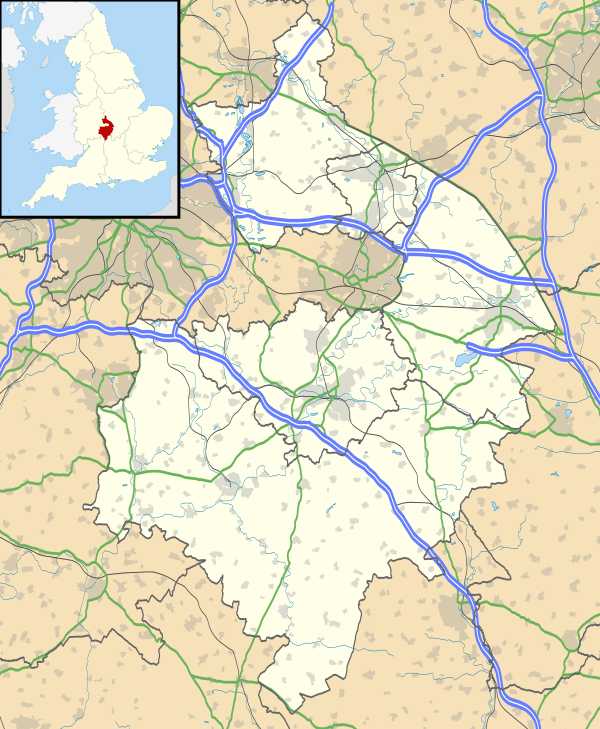RAF Long Marston
| RAF Long Marston | |||||||||||||||||||
|---|---|---|---|---|---|---|---|---|---|---|---|---|---|---|---|---|---|---|---|
| Summary | |||||||||||||||||||
| Airport type | Military | ||||||||||||||||||
| Owner | Air Ministry | ||||||||||||||||||
| Operator | Royal Air Force | ||||||||||||||||||
| Location | Long Marston, Warwickshire | ||||||||||||||||||
| Built | 1940 | ||||||||||||||||||
| In use | 1941-1954 | ||||||||||||||||||
| Elevation AMSL | 154 ft / 47 m | ||||||||||||||||||
| Coordinates | 52°08′15″N 001°45′09″W / 52.13750°N 1.75250°WCoordinates: 52°08′15″N 001°45′09″W / 52.13750°N 1.75250°W | ||||||||||||||||||
| Map | |||||||||||||||||||
 RAF Long Marston Location in Warwickshire | |||||||||||||||||||
| Runways | |||||||||||||||||||
| |||||||||||||||||||
RAF Long Marston was an English World War 2 military airfield, used by the Royal Air Force, that was opened in 1941 in the county of Warwickshire.[1]
History
The airfield was constructed in 1940 upon privately owned arable farmland requisitioned in 1939 for war use by the Air Ministry, the builder John Laing & Son being contracted by the British Government for the task.[2]
Its war-time facilities consisted of three tarmac runways in a standard R.A.F. 'A' configuration, with the primary one running for 1500 yards (the main runway would subsequently be extended to 2400 yards), and the other two 1100 yards each; an air-traffic control tower, two T2 hangars and one B1 hangar. It possessed also a mix of 27 pan and spectacle dispersals, which were used to spread the aircraft around the site to make targeting of them more difficult in the event of an attack by the Luftwaffe, and air-raid shelters. The airfield was equipped with ground assault defensive concrete pill-boxes, 2 of them of the distinctive "F.C. Construction" (or "Mushroom") type.[3] The facility also comprised billets to house up to 1000 air personnel.[4]
Unit history
The first R.A.F. unit based at the Long Marston was Bomber Command's No.24 Operational Training Unit (OTU), flying Armstrong Whitworth Whitleys, Avro Ansons and Vickers Wellingtons, which began operating at the field on 15 March 1943, using it as a satellite airfield to RAF Honeybourne. The Whitleys joined the unit after retiring from front-line service as an early Second World War night bomber when new four engined bombers like the Avro Lancaster took over the offensive.[5] Another unit based at the airfield was No.1681 Flight RAF flying Hawker Hurricanes and Tomahawks, whose duties involved providing simulated attacks against OTU aircraft to train the OTU crews in how to defend their aircraft in combat conditions. Their main base was RAF Pershore, with Long Marston used as a satellite station between 1 July 1943 and 21 August 1944.[5] No.24 Operational Training Unit ceased operations and withdrew from using Long Marston on 24 July 1945, two months after the fall of the III Reich.
Post-war the airfield's active use by the R.A.F. came to an end, and its facilities were closed in the late 1940s and placed under the authority of No.3 Maintenance Group operating from RAF Little Rissington until 1954.[6]
Accidents and incidents
RAF Long Marston experienced several accidents within its service life, such as:-
| Date | Incident | Reference |
|---|---|---|
| 5 February 1944 | Armstrong Whitworth Whitley LA929 of No. 24 Operational Training Unit (OTU) ran into a hedge after landing. | [7] |
| 4 April 1944 | Tomahawk AH885 of No. 1681 Flight RAF ran off the runway when landing and tipped onto its nose. | [7] |
| 23 September 1944 | Armstrong Whitworth Albemarle P1435 No. 296 Squadron RAF overshot landing, while towing Airspeed Horsa HG936. | [7] |
| 16 December 1944 | Avro Lancaster NG435 newly built by Armstrong Whitworth, crashed during a test flight. | [7] |
Post-military use
In 1954 R.A.F. Long Marston was decommissioned from public use by the Air Ministry, and the site was returned to the possession of the private landowners of the property in 1939. It was renamed 'Long Marston Airfield', and its facilities were made use of for the next six decades as a site for motor-sports events, and a variety of other commercial enterprises.
References
Citations
- ↑ "RAF Long Marston". Atlantik Wall. Retrieved 27 April 2012.
- ↑ "Our History - Warwickshire's angry skies". Long Marston Airfield. Retrieved 27 April 2012.
- ↑ 'The Pillbox Study Group' website (2017), entry for the F.C. Construction pillboxes at Long Marston. http://www.pillbox-study-group.org.uk/defence-articles/the-f-c-mushroom-pillbox/
- ↑ 'Long Marston Airfield - Sport & Leisure', commercial website detailing the history of the airfield (2017). http://www.longmarstonairfield.com/our-history
- 1 2 "Flying units in the south west midlands". Aviation Archaeology. Retrieved 27 April 2012.
- ↑ "History of RAF Long Marston". Long Marston Model Airshow. Archived from the original on 15 November 2012. Retrieved 27 April 2012.
- 1 2 3 4 "Aviation Crashes in the south west midlands during 1944". Aviation Archaeology. Retrieved 27 April 2012.
